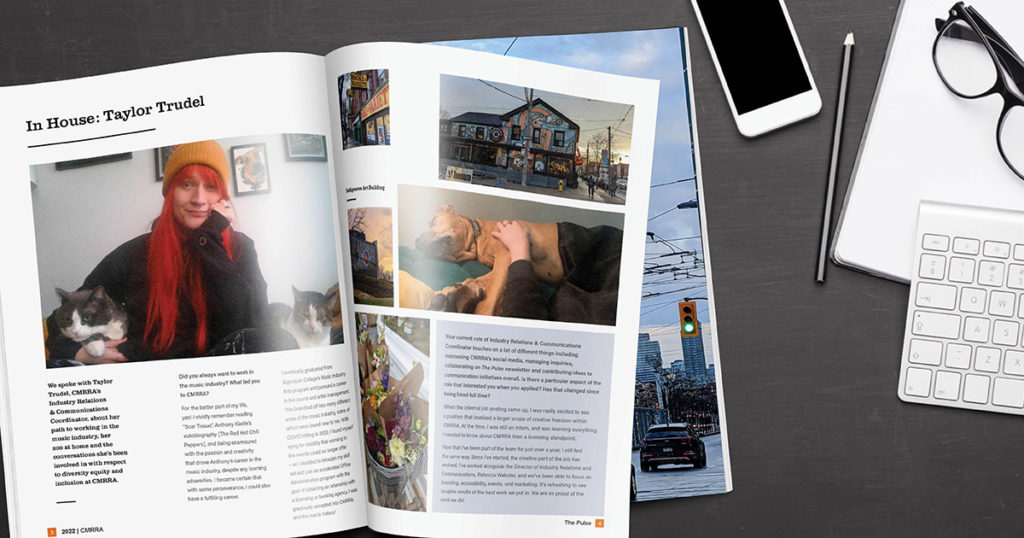We spoke with Taylor Trudel, CMRRA’s Industry Relations & Communications Coordinator, about her path to working in the music industry, her zoo at home and the conversations she’s been involved in with respect to diversity equity and inclusion at CMRRA.

Did you always want to work in the music industry? What led you to CMRRA?
For the better part of my life, yes! I vividly remember reading “Scar Tissue”, Anthony Kiedis’s autobiography [The Red Hot Chili Peppers], and being enamoured with the passion and creativity that drove Anthony’s career in the music industry, despite any looming adversities. I became certain that with some perseverance, I could also have a fulfilling career.
I eventually graduated from Algonquin College’s Music Industry Arts program and pursued a career in live sound and artist management. This branched off into many different areas of the music industry, some of which were brand new to me. With COVID hitting in 2020, I found myself vying for stability that working in live events could no longer offer – so I decided to broaden my skill set and join an accelerated Office Administration program with the goal of obtaining an internship with a licensing or booking agency. I was graciously accepted into CMRRA, and the rest is history!
Your current role of Industry Relations & Communications Coordinator touches on a lot of different things including overseeing CMRRA’s social media, managing inquiries, collaborating on The Pulse newsletter and contributing ideas to communication initiatives overall. Is there a particular aspect of the role that interested you when you applied? Has that changed since being hired full time?
When the internal job posting came up, I was really excited to see a position that involved a larger scope of creative freedom within CMRRA. At the time, I was still an intern, and was learning everything I needed to know about CMRRA from a licensing standpoint.
Now that I’ve been part of the team for just over a year, I still feel the same way. Since I’ve started, the creative part of the job has evolved. I’ve worked alongside the Director of Industry Relations and Communications, Rebecca Webster, and we’ve been able to focus on branding, accessibility, events, and marketing. It’s refreshing to see tangible results of the hard work we put in. We are so proud of the work we do!
This month we updated our newsletter colours to honour two important celebrations – Pride, which acknowledges the 2SiiLGBTQ community and the annual celebration of National Indigenous People’s Day on June 21. In the last year as we’ve had more focused conversations about diversity, equity, and inclusion at CMRRA, you’ve given us valuable feedback from your perspective as someone of Métis heritage and as part of the 2SiiLGBTQ community. Is having conversations enough to provoke systemic change and support for these equity-seeking communities? Are we on the right path?
Social issues in the music industry are always a work-in-progress. However, I sincerely stand behind the initiatives CMRRA has put into play regarding DEI culture in the workplace.
Early in my tenure at CMRRA, the news of the unmarked graves at the residential school sites started making headlines. At this time, I was personally approached by our President, Paul Shaver, offering his condolences and peer support – along with several other amazing colleagues. In this moment, I understood the compassion and truth behind the initiatives that the DEI committee worked so effervescently on. So, to answer your question, I do believe that CMRRA offers support to our equity-seeking communities, and has created great actionable initiatives, such as the CMRRA Next Generation scholarship with Humber College’s Music Business Administration program in an effort to broaden unique perspectives, diversity, and representation in the music industry.
Nevertheless, beyond CMRRA, I do believe that talk can be cheap, and we require more than conversations to provoke systemic change in the music industry. We need to ask ourselves, what are we doing as individuals to continue supporting equity-seeking communities once the tragedies stop headlining? If we want to understand these communities, we need to do a better job at listening to them. Take the time to download podcasts run by BIPOC and 2SiiLGBTQ folk, research up-and-coming songwriters, storytellers, musicians; share their work and make a genuine effort in your show of support.
If anyone has a virtual meeting with you, we often get visited by one of your pets onscreen… how many pets do you have currently?
You’re not wrong! They do love to make appearances. Dramatic entrances, as I would call them. Sometimes, it’s a mischievous cat falling through my aquarium, and sometimes, it’s an 80 lb dog flipping the couch upside-down while I’m on it.
I have a dog [Marmaduke], two cats [Apples & Minmin], a very special beta fish [Captain Finley], two axolotls [Grim & Medusa], a hamster [Beetlejuice], a poison dart frog [Zandy], various other fish, and most recently, someone dropped off a rabbit [Norman Bates], and never came back for him, likely because he’s a little unhinged… So, I guess he’s part of the family now, too. They’re the best part of working from home!
Do you have any new music to recommend to us?
I do! Back in April, Lights released a new album entitled PEP and I’ve had it on repeat ever since. 10/10 would recommend. I’ve also been loving Tanya Tagaq. Her collaboration with July Talk pairs traditional throat singing with elements of rock, which is right down my alley. Check out their single, Colonizer.
Thinking about becoming a client of CMRRA? Already a client but you have questions? Email us at [email protected] and we’ll get you the answers you need.


